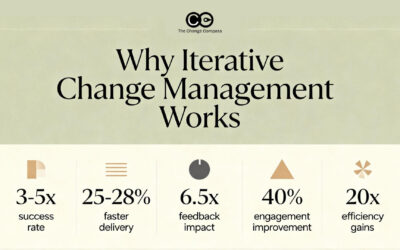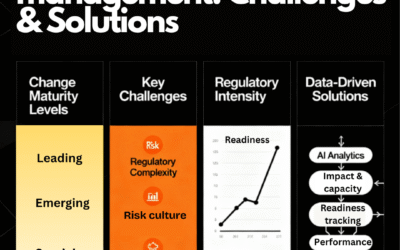There is now a lot of content out there on how to manage agile changes, including agile methodology and agile ways of working. This includes early and continuous engagement, creating a multidisciplinary team and designing smaller iterative changes. There are kanban and scrum approaches. What actually happens in organizations in terms of how people experience this? Most organizations experience this is a series of multiple initiatives going on, all iterating at the same time. The effect is various ripples of changes coming from different directions, with each initiative driving separate ripples.
Impact of agile changes
Let’s dive deeper into what this experience feels like for the organization. For the employee, changes are becoming more rapid than before with agile changes. Most organizations have at least several initiatives going on at any one time. Therefore, the employee will likely experience different changes at the same time. This could feel very overwhelming and hectic as the employee tries to keep up with a myriad of initiatives that are all working on the goals of the particular initiative.
For team managers this could also be equally overwhelming as various sources of initiative information is handed down and they are expected to be delivering and engaging their teams on the changes. Getting the details right is often a challenge and it is easy to just ‘pass down’ the given write-up about the initiative without talking through what it means specifically for the individual.
On top of this in a typical agile environment, there are always release changes and changes in the timeline. So, one of the challenges is that what is communicated through the various channels to engage employees will often be inaccurate as the dates change. This could create frustration and lack of trust as what is communicated keeps shifting.
For business unit managers the trick is to balance business-as-usual activities for employees and the demands of change initiatives. There can be occasions when there are simply too many changes at the same time impacting the same group of employees, whilst other times there seems to be little change – feast or famine. In this situation, there can be significant business performance impacts if there is too much change. Customer service levels may drop, customer satisfaction levels may be impacted, or work efficiency and work allocation may be impacted.
In a nutshell, the different ripples from different directions could all intersect and meet in one particular part of the business and create potential turmoil and business disruption. Which initiative is trying to do what? Which one benefits us more than the other? Which one requires more effort to get ready? These are typical questions faced by the business.
So how do we resolve this?
Planning and prioritization
Effective planning across initiatives is critical to managing the various ripples. There needs to be effective agreement across the organization which initiative has the priority using a set of agreed criteria. Typical factors include benefit size, strategic importance or any non-negotiables such as regulatory requirements. Both businesses and projects need to be part of this process. Data to support this process need to include all initiatives impacting a particular part of the business, whether it is deemed a ‘program’, ‘project’, or ‘BAU initiative’. The groups should look for opportunities to potentially ‘package’ certain changes that are more alike so that it is easier for employee absorption and adoption.
A key part of the input into this discussion is change impact. With clarity of the quantum and nature of change impact at any given time, along with other initiative information, decisions may be made on prioritization and sequencing. To read more about change portfolio management click here.
Communication and engagement
To effectively communicate with employees within an agile environment where there is constant shifting of timeline some use monthly release blocks versus communicating actual dates. Another way of addressing this challenge is to continuously remind employees the ‘why’ of the shifting timeline. This is focused on building employee expectation for the agile environment that there will often be constant shifting of dates and releases.
With multiple changes, it is also important to effectively link initiatives to their intent and goals. An overarching grouping or linking of initiatives to organizational strategies could be one way of doing this. In this way, it is easier to draw linkages for employees to seemingly disparate initiatives.
Business forums and routines
As a part of running an effective business operation, it is important to establish the right forums and routines to ensure that there is ongoing visibility of change impact. The routine should focus on examining the data on what the changes are at any given point in time, what happened previously in implementing changes, what will happen in the next quarter or month, and what actions are required to get the business ready.
There should also be regular examination of the level of ‘change heat’ to effectively manage business performance. Where there is a lack of heat there could be opportunities to fast-forward certain changes to balance the overall change loading.
The discussion on business readiness and capacity for change should be a balanced one, taking into account any operational challenges. These could include sales target stretches, resourcing levels, customer contact volumes, and other operational activities. In this way, the understanding of the employee capacity for change is taking into account a range of activities and focus areas at a given point in time.
The importance of change data
A critical part of creating an agile environment is a reliance on data. Agile teams are reliant on data in how solutions are developed, tested, deployed and evaluated. Without data it is not possible to test the hypothesis. In a similar way, the organization also needs to look at how it is collecting and analyzing change data to make effective business decisions. Managing the various ripples within the organization requires data-based decision making and not gut feel and hunches.
Read more about agile and change management in our article ‘The ultimate guide to Agile for change managers’ or ‘What we need to know about agile we learnt from change management’.
If you enjoyed reading this article please share this with your contacts.






